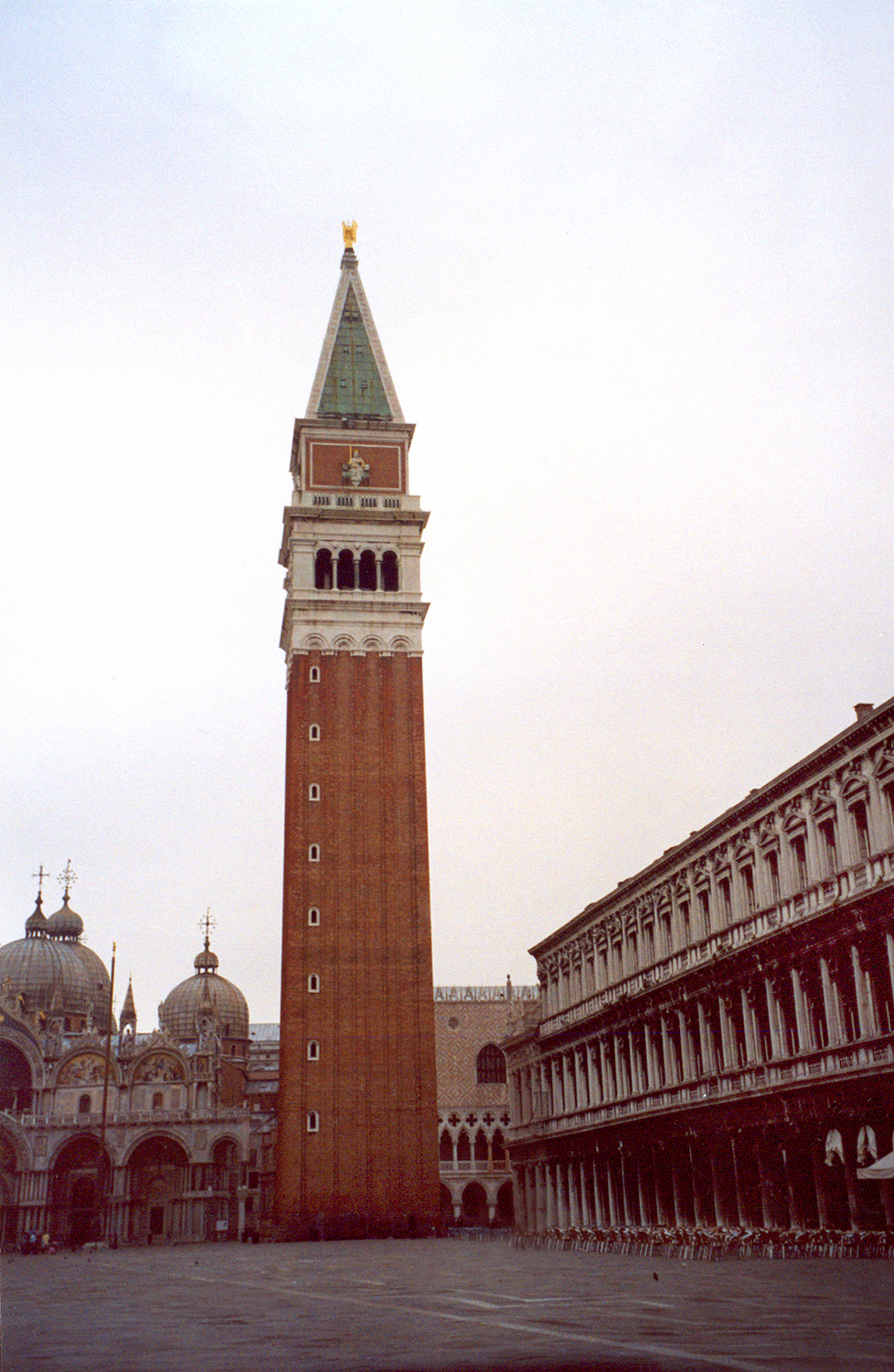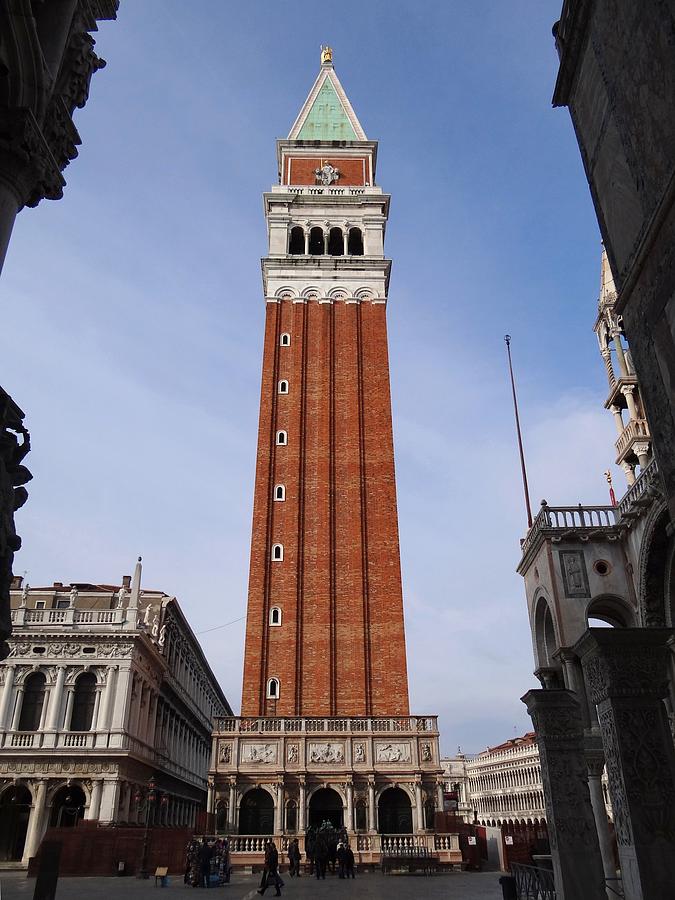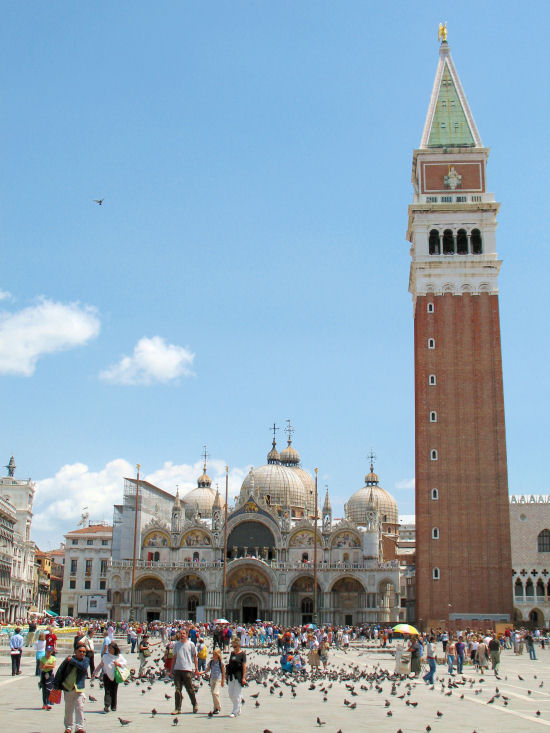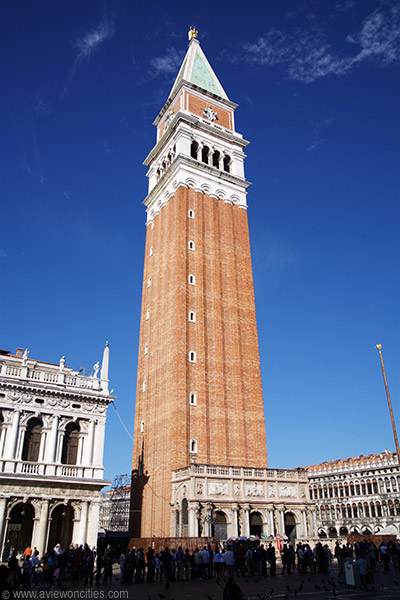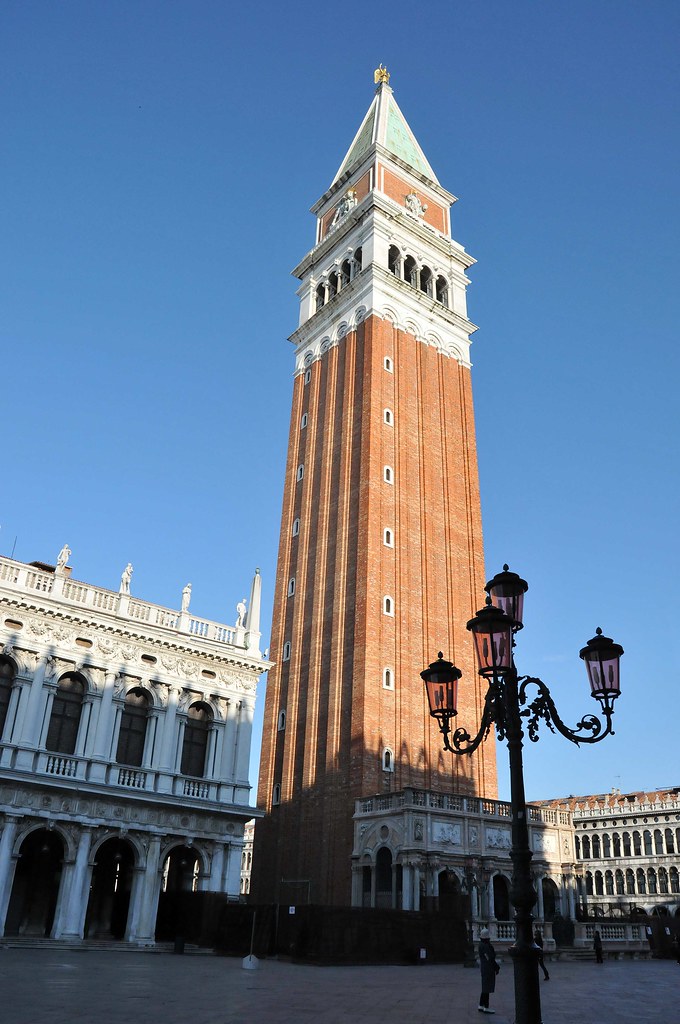St Mark's Campanile
The standing in Venice St Mark's Campanile ( Campanile di San Marco Italian ) is the Campanile ( bell tower ) of St. Mark's Basilica. Its height is 98.6 meters, thus he is the tallest building in Venice.
The tower is a symbol of the city. Traditionally, it was called in the Venetian " El paron de casa" ( the master of the house ). Numerous towers in Veneto and up to Dalmatia, originally Venetian dominion, are built as quotes Markus Tower and thus highly visible sign of dominion of the Serenissima, the historic Venetian Republic.
The beginning of the tower is 888-911 under Doge Pietro Tribuno. The construction work was interrupted several times; the tower was completed under the Doge Tribuno Memmo ( 979-991 ), a peak of baked clay was completed in 1152 under Doge Domenico Morosini, chiefly by the brothers Pietro and Giovanni Basilio. The top floor with the still visible sound arcade was added in 1178 and remodeled in 1329 again. The spire was placed in 1510 and 1517 with an angel made of wood, which was covered with gilt copper plate adds. It is the statue of the Archangel Gabriel.
Since 1548 custom is documented for the carnival Tuesday, an acrobatic performance on a rope that was stretched down from the tower. This so-called " volo de angelo" ( angel flight), originally " volo de turco " ( Turks flight to the first who performed this feat ), has been captured on paintings, for example, by Canaletto and Francesco Guardi.
Earthquakes and lightning strikes caused repeated damage to the tower and did restoration work required. On July 14, 1902 against nine forty-five clock tower collapsed after already days before large cracks in the masonry had formed, which were due to the fact that you had the metal anchors away inside the tower to install a lift. The accident caused great dismay and sadness in the world. The city council of Venice had already decided unanimously on the evening of tower collapse, the Campanile reconstruct how and where he had been ( com'era e dov'era ). Although the Viennese architect Otto Wagner said in an interview with the newspaper Il Piccolo ( Trieste ) of 17 July 1902 it would be to distort the history of architecture, the Campanile in the old style would be rebuilt, but he came predominantly negative reactions.
Reconstruction began on 25 April 1903. On April 25, the St. Mark, 1912, the restored tower was inaugurated. The pile foundations of the tower proved after about 990 years than they did very well, were completely petrified and therefore were only reinforced. However, this gain has led to new problems that threatened to become acute nearly 100 years later. Began in 2008 to secure the Markus tower with a Titanumfassung. Instead of the inner circumferential, leading upward ramp stairs was installed. Today, the top of the tower to prevent entry by a lift is available.
The five bronze bells of the highest tower of the city can be heard everywhere, so they were originally not only the call to worship, but had at the time of the Republic each have a specific function. The maléfico or Renghiera announced an execution, which Nona rang at noon, the Mezza Terza called the senators in the Doge's Palace and the Trottiera announced the imminent start of a session of the Great Council. The collapse of the tower was only the largest bell, the Marangona, which had been re-cast in 1819, intact. The Marangona was rung at the beginning and end of each working day and 1 call a meeting of the Great Council. The other bells were re-cast in 1909 in Milan: Pope Pius X took over for the costs. Even today, the five bells on an electric drive are rung regularly.
The Campanile was also the lighthouse and landmark of Venice. Emperor Frederick III. rode the continuous spiral rise in 1452 on horseback up to the belfry, as Napoleon and Lord Byron. Looking out of the belfry presents a fascinating view over the lagoon city and also a curiosity: you can see from there a Venice without canals.
The St Mark's Campanile has influenced the design of some other towers. Many are in cities with unique maritime embossing:
- The distinctive Kiel City Hall tower in the Schleswig-Holstein Kiel on the Kiel Fjord has been given, inspired to the Markus tower by architect Hermann Billing a facade structure.
- The tower of St. George's Cathedral ( slo. Sv Jurij. ) In Slovenia Piran ( Venetian Italian: Piran ) on the Slovenian Riviera was also inspired by the Venetian campanile.
- The Venetian towers in Plaça d' Espanya in Barcelona.
- The Metropolitan Life Tower in New York City was built 1908-1909 after plans by the architect Pierre LeBrun and Napoleon LeBrun. With a height of 213 meters and 50 storeys, he was until 1913 the tallest building in the world.
- The Sather Tower in Berkeley (California ), in reference to his model also called Campanile. He is the symbol of the University of California at Berkeley. Was built in the 93.6 -meter-high tower in 1914.
- The faithful (98.6 m high ) Mark Tower at the Venetian Resort Hotel in Las Vegas ( Nevada). The Venetian Resort Hotel is a hotel on the Las Vegas Strip, which was the Italian city of Venice modeled.
Tower of St. George's Cathedral is in Piran (Slovenia )
The Venetian towers in Barcelona ( Spain)
Metropolitan Life Tower in New York
Sather Tower in Berkeley (California )
The Venetian Resort in Las Vegas ( Nevada)

